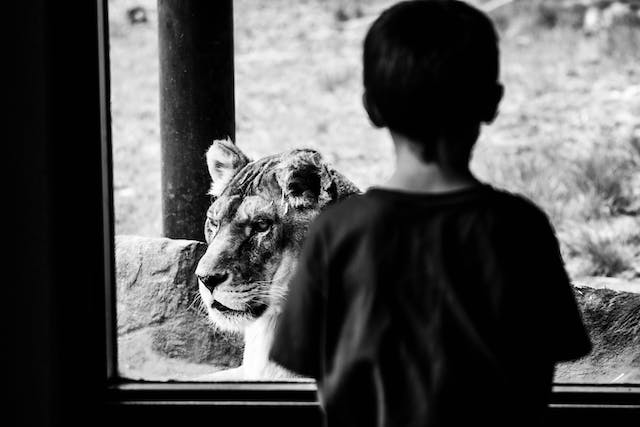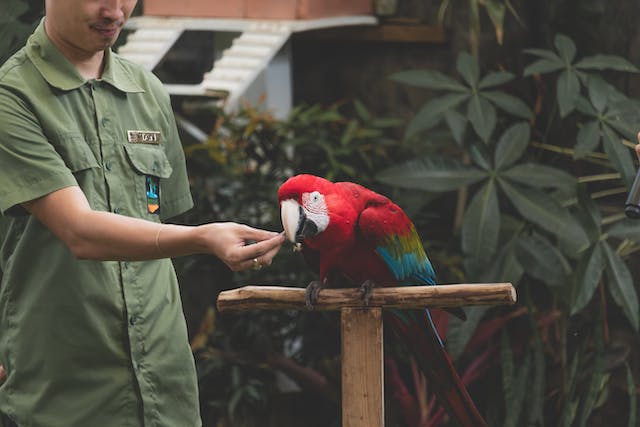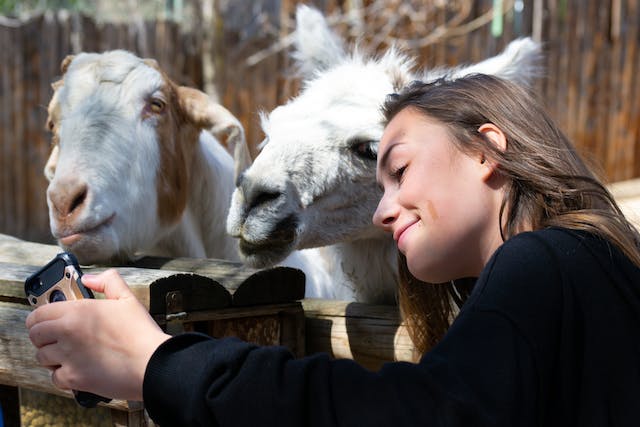Zoos have existed for thousands of years. According to historical records, wall engravings from Egypt and Mesopotamia show that zoos have been around from at least 2500 BCE.
Elephants, bears, dolphins, bears, giraffes, and birds all make appearances in these sculptures, which document the journeys of the handlers who brought them back.
The earliest zoos were termed “menageries,” or a small collection of exotic animals. They served two purposes: to raise their owners’ social and political standing and to amuse the ruling classes.
The “modern” zoo was established in the early 19th century. Zoos in major towns around Europe and the northeastern United States drew crowds of visitors eager to see exotic animals from faraway regions, thanks in part to a Victorian-era interest in natural history and a growing urbanization trend.
Since then, zoos have shifted their focus because of the looming threat of extinction and the destruction of their natural habitats. Zoos’ conservation efforts began in the middle of the twentieth century and have continued ever since.
Today’s animals in zoos serve various purposes, from education to ensuring the survival of their species that are on the verge of extinction in their natural habitat.
Zoos in New York City
There are five zoos and one aquarium situated in the five boroughs of New York City. Every borough has a zoo, and all of them are located in parks.
The Bronx Zoo is the United States’ largest metropolitan zoo. More than 4,000 creatures, many of which are uncommon and endangered, are housed in the zoo’s facilities.
Zoos and aquariums in New York City include the Prospect Park Wildlife Center in Brooklyn, the Queens Wildlife Center, and the Staten Island Zoo.
During the 1964 World’s Fair, the city’s first zoo opened in Central Park, while the city’s newest zoo opened in Queens after the fair ended.
Even though these facilities have many characteristics, each one is distinct in its own way.
The facilities are devoted to educating the public about wildlife conservation and preserving the species’ natural habitats.
Central Park Zoo
An animal sanctuary in New York City, the Central Park Zoo covers 6.5 acres (2.6 ha) and is located at the park’s southeast corner.
The Central Park Zoo, home to over 150 species of animals in the heart of one of the nation’s most beloved metropolitan parks, welcomes over 4 million visitors each year.
Its precursor is New York’s first public zoo, a menagerie, established in 1864.
Several years later, December 2, 1934, marked the beginning of an extensive rejuvenation initiative for New York City’s parks and recreation facilities, including the now-defunct Bronx Zoo, spearheaded by NYC Parks Commissioner Robert Moses.
The Civil Works Administration (CWA) and the Works Progress Administration (WPA) provided the bulk of the workforce and financing for its construction.
And in 1960, Senator Herbert Lehman and his wife Edith donated money to build the Children’s Zoo to the north of the main zoo.
New York City’s Central Park Zoo closed for reconstruction in 1983 after 49 years as a city zoo operated by NYC Parks. The zoo’s cages were replaced with naturalistic settings as part of a five-year, $35 million rehabilitation project.
When it was rededicated on August 8, 1988, it joined the World Conservation Society or WCS’s five other authorized zoos and aquariums in a system known as the Association of Zoos and Aquariums (AZA).
What’s interesting, however, is that Frederick Law Olmsted and Calvert Vaux, creators of the original Greensward Plan for Central Park, did not include the creation of New York’s oldest zoo.
A random collection of exotic pets and other creatures gathered near the Arsenal on the border of Central Park on Fifth Avenue facing East 64th Street unexpectedly formed from spontaneous gifts informally given to the park.
The Bronx Zoo
When the New York Zoological Society’s charter stipulated that the zoo be located within the city limits, Andrew Green played a crucial role in helping to make that decision.
Bronx Park, north of 150th Street, was chosen because it met several of the Society’s criteria for a big zoo and a recreation of the animals’ natural environment.
It was a rough, unimproved piece of land that included four natural basins and was a mix of meadow and forest. In 1899, the park officially opened to the public, and visitors were able to enjoy a unique experience thanks to the river that flows through the park.
Since its inception, the Bronx Zoo has housed and thereby safeguarded a wide range of creatures from all over the world.
The zoo currently houses more than 4,000 species and covers 265 acres. Gorilla Forest and Himalayan Highlands habitat visitors can get up close and personal with some of the zoo’s most elusive animals on a safari through the “open plain.”
Spectacular animals like the Indian rhinoceros, white-cheeked gibbons, black leopards, Malayan tapirs, and silvered leaf monkeys can be found in the recreated Asian rainforest.
Other locations include Cope Lake, containing gibbons and pelicans; Sea Lion Pool; Monkey House in Astor Court; Tiger Mountain; reptile house; an aviary; and Carter giraffe.
The Staten Island Zoo
The Staten Island Zoo, dubbed the “biggest little zoo in the United States,” houses more than 1,100 animals.
A pioneer in wildlife conservation, the Zoo houses over 70 species that are either extinct or facing extinction.
It also participates in breeding projects and educational outreach efforts to raise awareness about the predicament of these imperiled species.
In the globe, only 225 licensed zoos and aquariums are accredited by the Association of Zoos and Aquariums.
Colonel Edward Harden, a veteran of the Spanish-American War, had his estate and home demolished to make way for the Staten Island Zoo.
As part of her will, Mrs. Harden requested that her brother-in-law’s name be added to the property, that the land could not be utilized as a playground, and that her husband is permitted to live in the house that stood there.
She passed away in 1930, and the property was given to New York City. Barrett Park is the official name, although the “Staten Island Zoo” was the most common nickname throughout the 1960s.
The park and the Staten Island Zoological Society were part of the WPA’s works in 1933. Conversion of Harden Estate’s 8-acres into a zoo began in 1933, thanks to the city owning the land and forming a Zoological Society to manage and administrate it effectively.
The zoo initially opened to the public on June 10, 1936, and was the first of its kind in the United States. In 1942, the zoo employed its first full-time female veterinarian, making it the first American zoo to do so.
The Prospect Park Wildlife Center
In the late 1800s, Prospect Park began operating as a menagerie, just as Central Park’s Menagerie. There were 59 sheep, 28 deer, a buffalo and cow, three bears, a puma, two raccoons, ten rabbits, one dog, and one eagle living there in 1896, as well as 39 Chinese geese, 15 Egyptian geese, 7 Muscovy ducks, four common ducks and three turkeys.
When it initially opened to the public in 1935, it was renamed “Prospect Park Zoo on Flatbush Avenue.” Work Project Administration (WPA) projects like this one were also part of a vast city-wide park renovation plan under the guidance of Robert Moses.
By 1983, however, the Prospect Park Zoo had pretty much deteriorated. When a little boy died after falling into the polar bear pit, the park’s flaws were brought to light even more vividly.
For the next half-century, city officials and the New York Zoological Society worked together to maintain the three municipal zoos, which opened in Central Park, Prospect Park, and Queens, respectively, beginning in 1980.
The zoo began a $37 million renovation in 1987, which was finished in 1993. The renamed “Prospect Park Wildlife Conservation Center” became a nod to the center’s new emphasis on conservation education and the care of the smaller animals.
Natural habitat exhibitions replaced bars, cages, and pits. The World of Animals, Animal Lifestyles, and Animals in Our Lives were all created to encourage the younger generation to learn about wildlife. The sidewalk facing the Administration Building is even adorned with a 1993 sculpture composed of topiary frames shaped like animals.
The Queens Zoo
Robert Moses cut the ribbon on the Queens Zoo on October 26, 1968, to officially mark the facility’s opening. The existing aviary at the zoo was the geodesic dome from the 1964 World’s Fair.
The Queens Zoo had a 16 million dollar refurbishment finished in 1992 with a new name—the Queens Wildlife Center—subject to that 50-year arrangement with the Zoological Association to administer zoos in the city.
Because the City of New York still contributes to the center’s budget, it was at risk for budget cuts. At the height of the 2003 financial crisis, when then-Mayor Michael Bloomberg unveiled his “doomsday budget,” the zoo was forced to make significant cutbacks.
As a result of their low attendance, the budget suggested eliminating all public support from the Prospect Park and Queens Zoos. Finally, it was concluded that the expected $8 million in decommissioning costs for the two Zoos would outweigh the $6 million in savings from their closure. Thankfully, in the end, they decided that keeping the Zoos open was more cost-effective than shutting them down.
Today, tourists can walk from the entryway to many wild ecosystems, including the Great Plains, the California coastline, and a forest in the Northeast. More than a dozen species of animals from around the United States are displayed at the exhibit.



